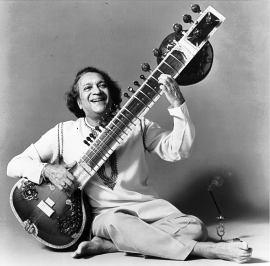|
 =
Melodious and Mesmerizing =
Melodious and Mesmerizing
Reviewer: The Rebecca Review
“Because I improvise completely (of course observing
all the complex discipline of the raga and tala forms) I feel
constrained performing for an audience with the knowledge that
it is being recorded for a DC. But luckily this time it
worked!” –Ravi Shankar
This was my introduction to Ravi Shankar, the famous sitar
player born in Benares, India in 1920. He was the first Indian
instrumentalist to attain an international reputation.
It is interesting to note that in 1962 he founded the Kinnara
School of Music in Bombay. In 1965, George Harrison of the
Beatles studied sitar with Shankar, and Beatle recordings began
featuring Harrison playing the sitar.
“Ravi, because of his upbringing and living in Paris and
traveling in Europe, could relate to all the musicians, theater
people and painters he met in the West. It also made him willing
to persevere to reach a mass audience, and led to the future
role he would have in really bringing world music to the
West.” –George Harrison (1943-2001)
As a youth, Shankar was a solo dancer who performed with his
brother Uday’s Indian dance troupe in Paris. He later married
Ustad Allauddin Khan’s daugher, Annapurna. His own daughter
“Anoushka Shankar (1981–), who studied with her father, is
also a virtuoso sitarist.” See B00000DCI0 for an album by this
artist. Here, she joins her father at Carnegie Hall where he
first performed as a musician and dancer in 1938. The same year
he became a pupil of the great Indian instrumentalist Ustad
Allauddin Khan.
Among Shankar's many musical compositions are the scores for
the motion pictures Pather Panchali (1954) and Apu Trilogy. He
has also collaborated with musicians like Zubin Mehta and with
composer Philip Glass in their electronic recording “Passages
(1990).
This is music which is probably still quite exotic for many
listeners, but you can be easily seduced into listening if you
give the music time to weave its magic spell. As the music
progresses you actually can become a bit mesmerized by the
sounds of the sitar, tabla and tanpura.

The sitar is indigenous to the Indian subcontinent and was
actually popularized by Ravi Shankar in the 1960s. It is a
fretted string instrument with a gourd-like body and a long neck.
It has from 3 to 7 gut strings, tuned in fourths or fifths or
both. There is also a lower course of 12 wire strings that
vibrate sympathetically with the first set.
Shankar believes that a “raga” is an aesthetic projection
of an artists inner spirit. This concert presents soothing and
exhilarating blends of contemplative raga forms.
The Hindu/Urdu word “rag” is derived from the Sanskrit
word: “raga.” This means color or passion. When you think of
raga, think of an acoustic method of “coloring the mind of the
listener with emotion.” Raga is technically one of the melodic
formulas of Hindu music having the melodic shape, rhythm, and
ornamentation prescribed by tradition.
The characteristics which define raga are:
The seven notes (Sa, Re, Ga, Ma, Pa,
Dha, Ni) of the Indian musical scale called “swar.”
The “swar” (notes) are assembled to make the scales. These
scales are called “saptak.”
Modal Structure called “that.” There are 32 seven-note
combinations of the “swar,” yet only ten are conventionally
accepted as “thats.”
Number of notes used in the rag called “jati.” A seven-note
rag is a “sampurna jati.”
Ascending and descending structure called: “arohana/avorohana.”
The “arohana” is the pattern in which a rag ascends the
scale. The “avarohana” describes the way a rag descends the
scale.
Important notes are called “vadi” (a note which is
strongly emphasized) and “samavadi.” (a note that is strong
but only slightly less so).
Characteristic movements to the rag called: “pakad” or
“swarup.” for instance the "Pa M'a Ga Ma Ga" is a
sign for Rag Bihag. The Indian Swar (notes) are Sa, Re, Ga, Ma,
Pa, Dha, Ni.
In addition to the main characteristics of “rag” there
are some that are attributed to times of the day. There can also
be male and female rags. Tradition dictates that certain rags
are performed at certain times of the day, seasons or holidays.
Playing rags at the wrong time may bring disharmony. At the
right time they may bring harmony.
Ravi Shankar has also been awarded an honorary knighthood by
the Queen of England.
See his autobiographies:
My Music, My Life (1969)
Raga Mala (1997).
Perfect accompaniment to an Indian-inspired dinner or just
when you want to take a sound journey. Also perfect for
listening to while giving or receiving a massage.
|
Indian
Swar
|
|
Shadj
|
Sa
|
|
Rishabh
|
Re
|
|
Gandhara
|
Ga
|
|
Madhyam
|
Ma
|
|
Pancham
|
Pa
|
|
Dhaivat
|
Dha
|
|
Nishad
|
Ni
|
|